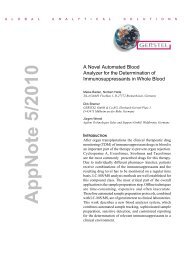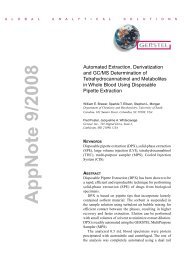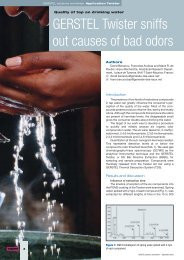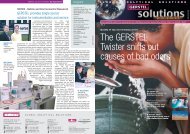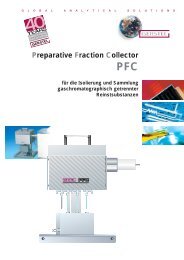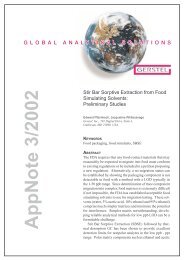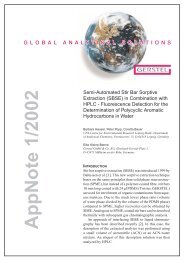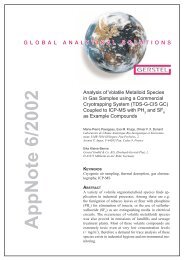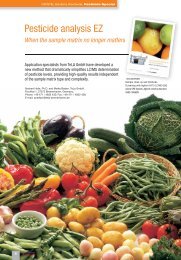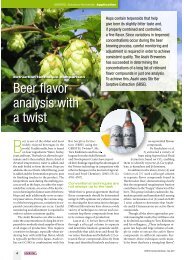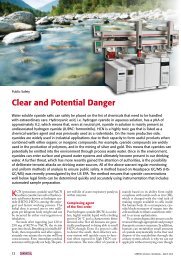Volatile Organic Compounds from Adhesives and their ... - Gerstel
Volatile Organic Compounds from Adhesives and their ... - Gerstel
Volatile Organic Compounds from Adhesives and their ... - Gerstel
You also want an ePaper? Increase the reach of your titles
YUMPU automatically turns print PDFs into web optimized ePapers that Google loves.
GERSTEL solutions worldwide Measuring Comparison<br />
GERSTEL solutions worldwide Measuring Comparison<br />
Figure 4<br />
Adhesive after<br />
7 days<br />
Figure 5<br />
Adhesively fitted<br />
carpet after 7 days<br />
14<br />
nents are not only difficult to detect,<br />
but can also influence the ambient<br />
indoor air to a great extent.<br />
Compared to low boiling solvents,<br />
these chemicals tend to migrate<br />
slowly out of the adhesive into the<br />
textile floorcovering <strong>and</strong> will<br />
furthermore lead to ongoing<br />
emissions of the material. Figure 4<br />
shows a chromatogram of an air<br />
sample taken in a test chamber above<br />
a pure adhesive in comparison to one<br />
of a fitted carpet containing the same<br />
adhesive after 7 days (Figure 5).<br />
Another experiment is shown in<br />
Figure 6. For the determination of longterm<br />
emissions <strong>from</strong> adhesives<br />
(prediction for real rooms), a chamber<br />
measurement has been performed<br />
over 100 days. A carpet, glued on a<br />
glass plate was measured for this long<br />
1 Butyl Diglycol<br />
2 Methoxypropenyl Benzene<br />
3 Phenoxy Ethanol<br />
4 Dimethylbicycloheptene Ethanol<br />
5 Butyl Diglycol Acetate<br />
6 Terpene<br />
7 Longifolene<br />
8 Butyl Triglycol<br />
Figure 6<br />
Long-term<br />
emission (TVOC)<br />
of a glued carpet<br />
in a test chamber<br />
Figure 7<br />
Test chamber<br />
period of time in a test chamber (Figure 7)<br />
to obtain more information concerning<br />
the long-term emission behavior of<br />
glycols <strong>and</strong> glycol ethers.<br />
An actual situation similar to the test<br />
chamber compounds, has lead to a long<br />
lasting emission of volatile components<br />
into the indoor air. As shown in Figure 8 in<br />
a real room situation these high-boiling<br />
components, such as phenoxy ethanol,<br />
do not appear immediately, but instead<br />
after a period of time after installation. In<br />
this particular case, the office had to be<br />
renovated after nine months due to the<br />
complaints of the users <strong>and</strong> according to<br />
the emission data.<br />
Another example shows that air<br />
analysis alone does not necessarily solve<br />
indoor air odor problems. In this case an<br />
extremely annoying bad smell was<br />
reported in an office room. Indoor air<br />
analysis resulted in the detection of<br />
bromophenol (Figure 9), but neither the<br />
floor covering nor the adhesive contained<br />
even traces of this compound. The<br />
combination of carpet <strong>and</strong> adhesive led<br />
to the formation of bromophenol <strong>and</strong><br />
placing a piece of carpet (with the<br />
Figure 8<br />
Real room<br />
situation in a<br />
newly<br />
constructed<br />
office building<br />
adhesive applied) in the thermal desorption unit <strong>and</strong><br />
performing thermal extraction could reproduce the bad<br />
smell.<br />
Figure 10 shows the mechanism of formation:<br />
phenoxy propanol (<strong>from</strong> the adhesive) is hydrolyzed to<br />
phenol, which itself reacts with inorganic bromide (<strong>from</strong><br />
the latex back of the textile covering) forming<br />
bromophenol.<br />
Conclusions<br />
<strong>Volatile</strong> organic components <strong>from</strong> water-based<br />
adhesives have a major influence on the indoor air<br />
quality. Due to the use of high-boiling <strong>and</strong> polar<br />
compounds, the impact of the problem has been shifted<br />
<strong>from</strong> the installation process to the consumer or<br />
inhabitant of the office. The emissions of these<br />
compounds are a major problem of indoor air pollution.<br />
As shown in this paper, the influence of adhesive<br />
components on the long-term emission is substantial<br />
<strong>and</strong> by using the wrong analytical technique the true<br />
magnitude of the problem for the indoor air situation can<br />
be severly underestimated.<br />
After having learned about the situation, a new<br />
testing scheme for the long-term emission of adhesives<br />
was developed by the association of adhesive<br />
manufacturers <strong>and</strong> the association of environmentally<br />
friendly carpets.<br />
Figure 9<br />
Direct thermal<br />
extraction of<br />
carpet material<br />
<strong>and</strong> an adhesive<br />
1 Butanol<br />
2 Methyl Propionic Acid<br />
3 Butyl Isopropylene Glycol<br />
4 Benzaldehyde<br />
5 Phenol<br />
6 2-Ethyl Hexanol<br />
7 Bromophenol<br />
8 Phenoxy Propanone<br />
9 Phenoxy Propanol<br />
10 4-Phenyl Cyclohexene<br />
11 Isolongifolene<br />
12 Longifolene<br />
Figure 10 Mechanism of<br />
formation of bromophenol<br />
Our service <strong>and</strong> sup<br />
network: Distributo<br />
Australia<br />
Lasersan Pty Ltd.<br />
P.O. Box 3279<br />
AUS-Robina Town Centre, QLD,<br />
Phone: +61 (417) 627667<br />
Fax: +61 (7) 5525 2533<br />
Benelux <strong>and</strong> Sc<strong>and</strong>inav<br />
Analytical Applications Brielle B.V<br />
Oever 1, NL-3232 GN Brielle<br />
P.O. Box, NL-3232 AB Brielle<br />
Phone +31 (181) 416555<br />
Fax +31 (181) 418600<br />
France<br />
Analytical Applications Lyon S.A.<br />
7, Place Antonin Poncet<br />
F-69002 Lyon<br />
Phone: +33 (478) 380567<br />
Israel<br />
Eldan Electronic Instrument Co.L<br />
Idan twin building<br />
New industrial park Afek<br />
21 Ha’Melacha st.<br />
IL – 48091 Rosh Ha’Ayin<br />
Phone: +972 (3) 9021330<br />
Fax: +972 (3) 9021331<br />
Italy<br />
Abreg s.r.l.<br />
Via Montello, 20<br />
15100 Aless<strong>and</strong>ria<br />
Italia<br />
Phone: +39 (0131) 325124<br />
Fax: +39 (0131) 510972<br />
Japan<br />
Yokogawa Analytical Systems Inc<br />
Sales Department / Gas<br />
Products<br />
Mitaka Takagi Bldg.<br />
1-15-5 Nakacho, Masashino-shi<br />
J – 180 Tokyo<br />
Phone: +81 (422) 56-9393<br />
Fax: +81 (422) 56-9449<br />
Korea<br />
Young In Scientific Co., Ltd.<br />
Young-Wha Bldg. 547<br />
Shin Sa-Dong, Kang Nam-Ku<br />
Seoul, 135-120<br />
Korea<br />
Phone: +82 (2) 519-7300<br />
Fax: +82 (2) 519-7400<br />
Pol<strong>and</strong><br />
CHROMTEC<br />
Chromatographia Apparature Akc<br />
Ul. Rakowiecka 36/253<br />
PL – 02532 Warszawa<br />
Phone: +48 (22) 6063883<br />
Fax: +48 (22) 8491054<br />
Spain<br />
Andaluza De Instrumentacion S.<br />
Centro de Empresas Aljarafe<br />
Poligono Industrial PISA<br />
C/Horizonte, 7, 3aPlanta, Mod. 1<br />
E-41927 Mairena de Aljarafe – S<br />
Phone: +34 (95) 5600117<br />
Fax: +34 (95) 4182034<br />
United Kingdom<br />
Analytical Applications Reading L<br />
University of Reading<br />
Reading<br />
GB-Berkshire RG 6 6BX<br />
Phone: +44 (1734) 861361<br />
Fax: +44 (1734) 861894<br />
15<br />
GERSTEL solutions worldwide E 1/2000<br />
GERSTEL solutions worldwide E 1/2000



